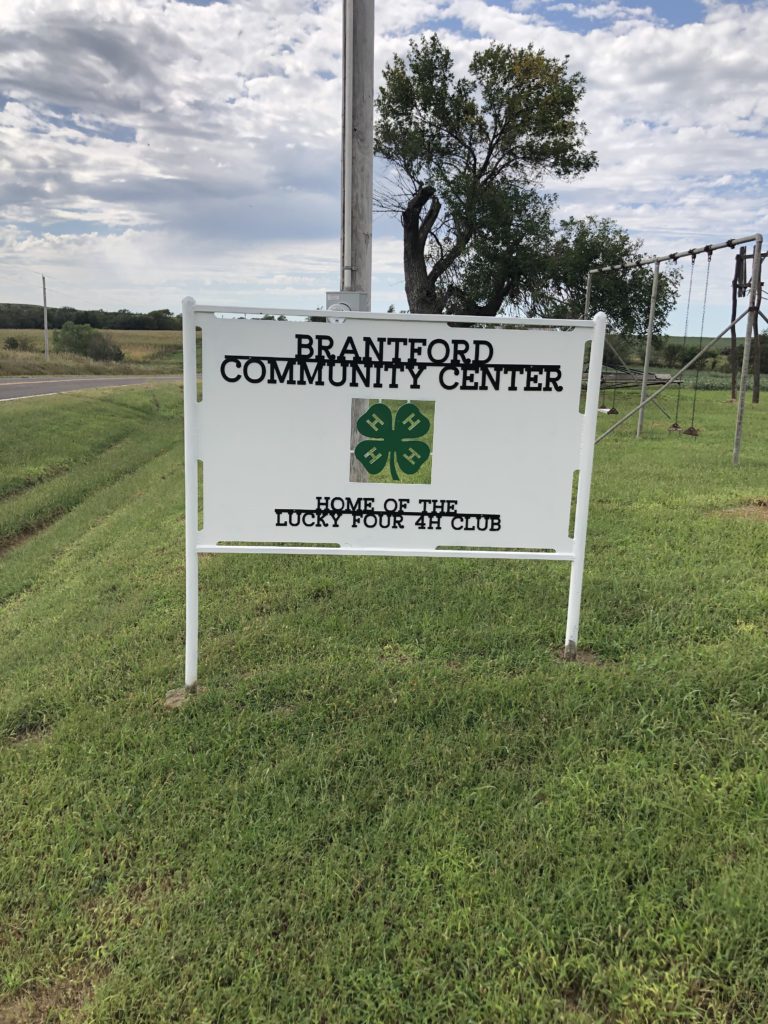 I love driving the country sides searching for Ghost Towns. It’s difficult to imagine that an empty field of corn once housed and entire community but I like the challenge. This last week I spent the day in Washington County Kansas with a friend. She had to the key and permission to the Brantford school house where she thought we might find some history. We stopped and talked to 98 year old Dean Seifert who lived next door and he gave me as much history on the town as he could remember and pointed us to a few other places where there were communities long gone.
I love driving the country sides searching for Ghost Towns. It’s difficult to imagine that an empty field of corn once housed and entire community but I like the challenge. This last week I spent the day in Washington County Kansas with a friend. She had to the key and permission to the Brantford school house where she thought we might find some history. We stopped and talked to 98 year old Dean Seifert who lived next door and he gave me as much history on the town as he could remember and pointed us to a few other places where there were communities long gone.
BRANTFORD, KANSAS
Grandma Alta and her family grew up in the Brantford area and her father, mother, and brothers are all buried in the cemetery there, so I was curious as to what the Brantford community was like while she was growing up. Mr. Seifert didn’t know or remember the McCollums but he recalled older folks speaking of them and he wasn’t sure but believe they may have lived north of town in a rock house. He too had grown up east of Brantford in a big rock house, which is now in the Clifton address, and I was allowed to take a tour of it.
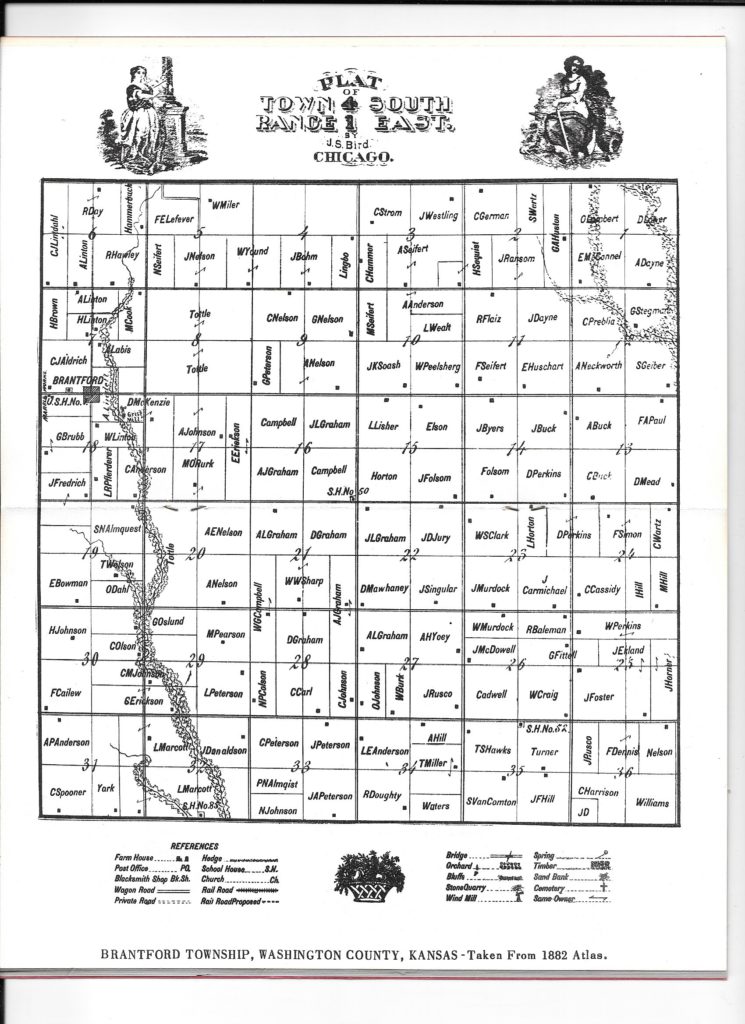
THE TOWN OF BRANTFORD
Brantford was homesteaded mostly in the years from 1869 to 1871. The pioneers took timber claims under the Government Act. Some that took homesteads got discouraged and gave up their claim and went back to their former homes. Those that stayed endured many hardships, such as grasshopperas that ate their crops, wind and dust storms, drought and prairie fires.
Part of the State was covered with very tall blue stem grass. It was said that when this dry grass caught fire it spread rapidly under a high wind. (wind in Kansas?) At one time the fire jumped the Republican River, which is 11 miles south of the Brantford Township. Although it was difficult many stayed and reared their families here. Some lived in dugouts, and some in log houses, and some in one room frame houses. The blue stem sod was broken up with breaking plows drawn by horses and oxen. After this soil was broken up it proved to be very fertile soil and would grow a diversity of crops. Cattle and hogs also have taken their place around the community.
The township has five very well kept cemeteries. For many years it housed five country churches. The pioneers didn’t forget their God. Worship service was conducted in private homes and in school houses until they were able to build churches.
In the earlier days there was a family on almost every quarter section, sometimes on 80 acres, but today one can drive several miles and not see a farmstead. Many have moved away and death has taken it’s toll. The farms have gotten much larger. This has been a setback to many of the churches and schools. There are no longer country schools as children are today bused to the larger communities.
Dean Seifert remembered when Brantford was a busy little community. He talked about the two grocery stores and the creamery north of town. On Friday and Saturday nights he said the main street would be lined with horses and buggies with people bringing their eggs and cream to the store to “trade” The people would bring their instruments and would put together a band and they would have dances in the store. He told of the children playing in the school yard and the service station on the corner which now has fallen to a pile of brick.
It’s not known how Brantford got it’s name but it came into being around 1869. The first Post Office was run by Henry Brown who received a large sum of 16 dollars a month, which was considered a fortune at that time. Mr. Brown sold a few drug and groceries in his place of business. One of his daughters became the wife of John Campbell.
Before the rail road came to the area, mail was brought to Washington and then by pony express to Enosdale, Throop, Strawberry, Brantford and Clyde. Washington and Clyde are the only of these communities still incorporated. The others are now merely a memorial marker along side of the road with a cemetery nearby.
The mail was brought once a week. People would walk to get the mail. Later the mail was brought out from Clyde several times a week. Some time later there was an RFD from Clyde, Kansas by vehicles drawn by horses. When the auto came into use around the 1900’s things sped up a bit.
Later there was a man by the name of Mr. Lydell who ran the store for a time.
Bill Jurey remembered that the first store building was a large frame one and was known as the Bradley Store. The Bradley Store was built quite high off the ground with a front porch. The merchandise was hauled from Clyde and Agenda, the nearest railroads then, by team and wagon. This high porch was where the wagons were backed in and unloaded. Steve Bradley, SR. operated the store. It was a general store that stocked dry goods, shoes, groceries, etc. They had large rolls of cheese about 12 to 14 inches in diameter which were cut much like we cut round cakes today. There was a large tobacco knife with a long handle used to cut the plugs of tobacco. Also there were old fashioned butter kegs and all the other things that went with an early day store.
The William Campbell family from Clifton moved to a farm one fourth mile west of town in 1884. At that time Steve Bradley, Sr., who had migrated from England, ran the General Store. Later he moved to Agenda and built a store there. His brother, Charles took over the Brantford Store and continued to operate it for a number of years. He too later moved to Agenda.
Mr. Lacey and his family continued to operate the store. Then he sold it to Mr. Robinson. This building later had a shoe shop and harness shop operated by Art Leiszler, F. Ocar Peters and Bill Erickson sold implements and repairs. Gust Hammar then started a grocery store again. Later M.E. Hammar, Glen Anderson, and Ernie Lahodny each owned the store in succession.
Another General Store Comes to Brantford
Around 1900, Mr. Albert Anderson and his brother, Henry built a large store building a block west of the former store. Some of the operators were Albert Anderson , Steve Bradley JR. , John Smith, Henry Trybom, Victor Hendrickson, JA Peterson and Glen Anderson. Albert Anderson and his borther also sold implements while in the store. Both stores did a good business for a number of years. There were many more people living in and around the community at that time.
Mr. and Mrs. Ernie Lahodny purchased the Calderhead Store building in the 1930’s and moved it to Brantford. This was a nice large building with a living quarters in it and besides the store they had a locker plant. They enjoyed a good business for several years. This was the only store in town at this time as the two old stores were torn down.
Telephones come to Brantford
Mr. Tom Dolan was the first to bring telephones to the town around 1900. He was a brother in law of Wm Campbell and lived in Clifton where he had a telephone exchange.
The Brantford Telephone Company, as it was known, had a number of farmaer owned lines with a Central Office located in Brantford. Some of the operators throught the years were AJ Anderson, Mrs. Oliva Day, George Hyland, John Shea, Mrs. Bertha Huncovsky, Mrs. Vira Hanshaw, Mr. and Mrs. Charles Anderson, Mr and Mrs. Arnold Andrewson, and Mary Lahodny. This Exchange was sold to the Cuba Exchange in 1960.

A Creamery
The creamery was built a short distance north of the road intersection, now only a pile of rubble marks it’s spot. Mr. Armstong of Clyde and Mr. Skinner were the operators. Cream and milk was picked up by a team and wagon or spring wagon. The cream was churned into butter and shipped out. Later they ceased to churn butter and the plant was used to separate milk and cream. The only coolers the farmers had in those days was the stock tank into which they put the cream cans to cool.
Some people had dug wells that were 3 1/2 to 4 feet across. They would tie a small rope to the can and lower it into the well several feet where it would stay really cool. Sometime the rope would unwind or break and the can would fall down into the well. The the water wouldn’t be good to drink for some time. They used this method for cooling butter also.
Bank Idea Failed
In the early 1900’s there was talk of starting a bank in town but this never came to pass. For many years thousands of bushels of grain was hauled through this little town to Agenda by team and wagon. Agenda was the nearest railroad. People were hoping that the Rock Island would build a spur to Brantford. The United Brethern Parsonage was located in Brantford for a number of years. The Brantford Cemetery is one half mile south west where many of the old pioneers are laid to rest. This is where you will find our great grandfather Francis Marion McCollum and his two wives, and several of his children. His father Enos McCollum is also buried here.
Black Smith Shop
There was a black smith shop in Brantford. During it’s existence it was operated by Nels Holmberg, Dick Osborn, Art Weckworth, and Mr. Nailer.
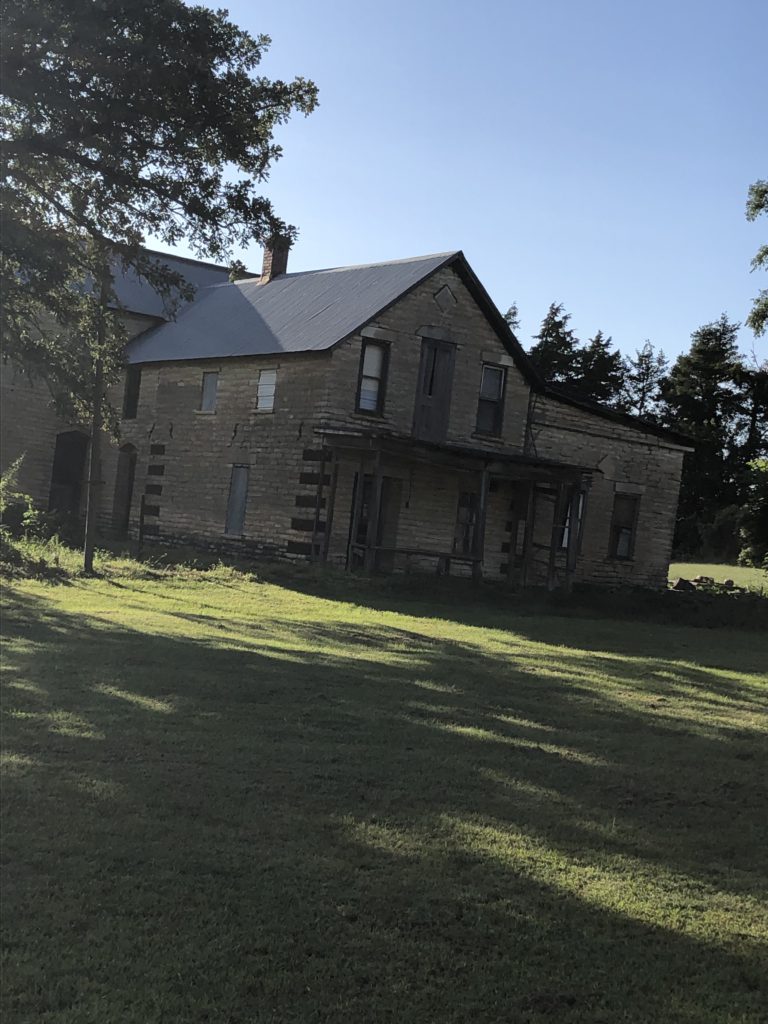
McKenzie’s Mill
To the east one-fourth mile across Dry Creek at the top of the hill on the south side of the road on the McKenzies farm stood a large grist mill. This was a round structure built of native stone. I was about 20 ft in diameter and about 35 to 40 ft hight. On the top was a wind propeller something like an old Dutch Windmill. It had a large wheel probably 24 ft across and this would be turned to the wind to power the mill. In early days people would bring grain of all kinds to have it ground into meal and flour. The structure was taken down in later years. It is too bad it was destroyed as it would have been a real land mark and monument to the past.
Clarence Erickson built a large time garage on the south side of the road. He did a large repair business and employed extra help . His health deteriorated and he hand his family moved to California. Some of the later operators were Wendel Clack, Kenneth Shultz, Nyle Sarff, and Ed Chapla. Now only a pile of tile brick remains with a hint that a garage may have stood.
There was a time that Richard Hammar ran a shoe and harness shop. Albert Miller had a grist mill powered by a large gas engine. He made corn meal and breakfast foods. In the early days there was Dr. Burk that lived in Brantford. There were three gas pumps in town and at least 10 families. Today there is but one house which is were Dean Seifert now lives.
The LAST BUSINESS
Mr. and Mrs. Ernie Lahodny closed the last place of business in the dying little town in 1962. Ernie took a job with the State Highway at Belleville, and they sold the contents of the store thru an auction sale that lasted several days. The day that one could shop for almost anything in Brantford had ended.
The names of some of the older people who made their homes in the area in the earlier days are as follows: The Bradleys, John McCullough, Aldrich, Simpson, Templton, Olson, John Anderson, Carl Anderson, Perkins, Brown, Otto Nelson, Nels Holmberg, Oscar Ahlstead, Greenwood, Dr. Burk, John Carmichaels, Archie Grahm, Chas. Johnson, Alfred Erickson, Gut Magnus, Dave Lindahl, Emil Anderson, Little Anderson, McKenzies, AV Erickson, Albert Miller, A Youngbloom, Bob Peterson, AJ Anderson, Henry Anderson, Oscar Phil, Press, Tom Roe, Wm. Campbell, Carl Noren, Joh Larson, F. Oscar Peterson, Godfred Fredrickson, Alfred Swanson, John ampbell, Justine Holberg, Bill Meyer, Mr Fagerber, Mrs. Erickson, Gust Hammar, Richard Hammer, Frank Seifert, to just name a few.
Eric Erickson
Eric Erickson and his family came from Sweden and settled in Junction City where he worked as a stone mason before he came by covered wagon to homestead a farm just east of the Lutheran Cemetery. Here he and his family lived in a dug out while his home was being built of limestone rock on a 160 acre farm. The remains of this dugout may set be seen just east of the east fence of the cemetery. His children born in Sweden were Andrew, and John. William was born in the dugout. Later three daughters, Mattilda, Josephine and Emma were born.
After the rock house was built, church services were held there until the lutheran church was built. It was an exciting life, especiall when the long horn cattle came in droves from Texas and ran around the dugout. Rattlesnakes were a bothersome problem of the time.
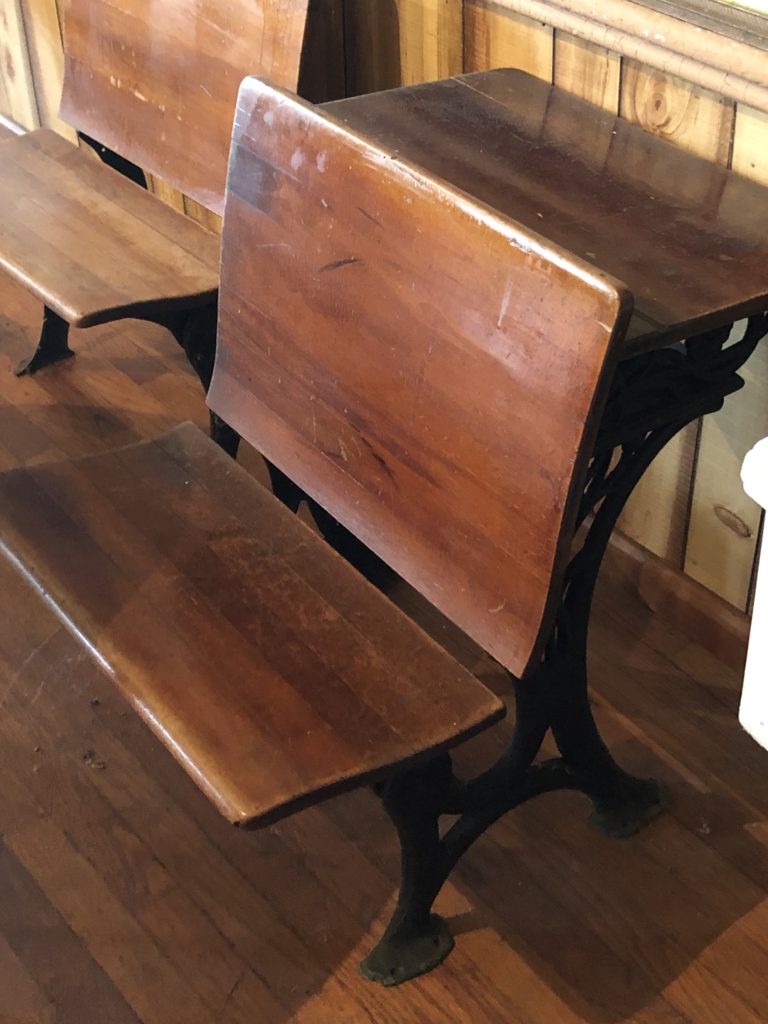 THE SEIFERT SCHOOL
THE SEIFERT SCHOOL
The Seifert school district was formed in 1875 with the first director being Andrew Seifert, first clerk being Frank Seifert, and the first treasurer was Gustaf Nelson. A bond of $150 was posted in February 1875 with an addition one of 300 in August of the same year.
In 1878 the tax levy for school purposes was 2 mills.
The land description of the Seifert district was starting at the NW corner of section 4 township 4 south range 1 east, then east to the NE corner of section 3, then east to the center of section 2 then south to the center of the south line of section 11 then west to the SW corner of section 9 then north to the place of beginning all in township 4 south range 1 east. In 1963 there were 5 children in the area, compared with 44 enrolled in the school in 1898.
It’s my assumption that this is the school most likely that Grandma Alta attended as the McCollum name was among the children enrolled there between 1920 and 1930. We know the McCollums left Missouri in the fall 1912 when Grandma was just a baby.
According to records the first school house was built in 1875 of native stone with a sod roof, stove, blackboard, books, etc., were purchased and installed and the first teacher was Ellen Hutchinson, who was hired and started the school with 17 pupils enrolled.
In 1884, the stone school house was raised and a one room wooden structure was erected. The school house was partitioned into 2 rooms and in 1918 that was the extent of modernization.
In the 1890’s and early 1900’s names of pupils included Hammers, Nelsons, Naults, Seiferts, Westlings, Johnsons, Sheas, Bohms, Ericksons, Hendersons, Rasmusons, Urbans, Andersons, Burts, Carlsons, Corbetts, and Nixons. Students of all ages came to school to learn to read and write, some to learn English. School was a hit or miss affair in those days, being held as long as money held out to pay a teacher and as long as a student could be spared from the farm long enough to attend. Students could go as long as desired and as long as they could learn something new. Nine years of schooling wasn’t unusual as it was not possible for many to go to high school so they went to the little grade school to get all the education possible. School wasn’t as necessary then as it is today so many didn’t go very many years of very regularly.
Subjects in the early days were referred to as the three R’s (reading, writing, and arithmetic) but studies were very thorough. In the first grade writing was done on slates. Reading, writing, and language and spelling for instance, were so interwoven as to be included in one lesson. General lessons included ethics, talks on the human body, animals, etc, and object and color lessons.
Second grade work included reading long and short vowels, spelling phonetically and by letter and pronunciation and to write each word in sentences until various meanings are learned. Number work included drill in rapid combinations of all digits adding single and double columns, subtraction and learning the complete multiplications tables. Reading and writing numbers to s places and learning Roman numbers to C. General lessons continued much as first grade. Ethics was taught by continuing to find occasion to lead children onto higher and purer thoughts, to eradicate selfishness and to cultivate generosity. (Something we could use more of today!) Teachers were to relate anecdotes, citing noble deeds of great men. Physical training was emphasized by hold 2 minute calisthenics in the fresh air.
All this was in the first 2 years. We talk about busy teachers today, perhaps a good look at our past school teachers would be in order now to further the progressive education.
Geography was taught by acquainting the pupils with familiar places, the school yard, neighborhood, township, county, and state, leading to study of the globe and the earth as a whole-form, size, land and water forms and motion of the earth causing day and night.
Before passing into another grade, a pupil had to pass a satisfactory examination.
The “old country school” had a system almost identical to the brainstorm of the modern educators of ungraded advancement according to ability. For instance a child may be classified in the 5th year but doing 7th year arithmetic. In other words a child progressed according to ability and was alled to progress at his won rate with special emphasis on weaker subjects. The only thing required for advancement as rapidly as each subject was mastered was the stated exam. This information of subject studied and progam of advancement was obtained from an 1898 teachers classification register.
One of the most outstanding memories of one of the pupils was the great sense of wonder at the sound of a recorded human voice. The first these people had an opportunity to do so was provided when the teacher, E.W. Burt brought a gramaphone to school in 1897.
Names of students in the years from 1910 to 1920 included, Seifert, Johnson, Peterson, Erickson, Hammer, Gieber, Nutter, Burt, Brichat, Shea, West, Anderson, Phelps and Hart. In the years from 1920 to 1930 were Peterson, Johnson, West, Grahm, Noren, Steel, Hammar, Hendrickson, McCollum, Merritt and Miller. From 1936 to 1941 families were Sorell, Seifert, Nelson, Trybom, West and Anderson.
The Seifert school house closed it’s doors for the last time at the end of 1940-41 school year. The last teacher was Russell Hammer and the 7 students continued their grade school education at the Graham school located 3 miles south and 1/2 west of the Seifert school. Nothing remains of the old school building except a small pile of stones and cement as the building was sold and moved away. It’s history only remains as a time in which our ancestors lived, and memories that have been told and handed down.
History of the teachers that served.
1876-1877 Ellen Hutchinson (salary $17) , 1878 W.S. Hutchinson ($28), 1879 Ivaloo Winder ($23), 1880 C.W. Flaiz ($28), 1881 Hattie Perkins ($28), 1882 Lucie Seven ($28), 1883 -1884 Frank Skipton ($40) 1885 William O. Linton ($35) 1886 W.E. Jenkins ($25) . This year school started in Dec. and lasted 2 mo. and 2 days. 1887-1888 W.E. Jenkins, 1889 Elwood Lower ($35). there is no record for 1890. 1891-1892 Bell McConnell ($25) , 1893 Alice Howley ($28), 1896 Olive Paul ($22),1897 E.W.Burt ($25), 1898 Abbie Dingman ($30) 44 students aged 4 to 21. , 1899 Marion A. Hyland $(26), 1900 Seth Sandy ($30 ), 1901-1902 Effie Driskell ($30), 1903 Laura Campbell, 1904 Laura Campbell ($30), 1904 Viola Burk ($35), 1905 Ethel Burk ($35), 1906 Mollie Meyer (35), 1907 Esther Nelson ($37.50), 1908 Norma Williams ($37.50), 1909 Ester Nelson ($40), 1910 K. Mae Nutter ($45), 1912, Grayce Stewart ($50), 1913- 1915 G. Anna Brooks ($45-$50), 1916 Jessie R Sprague (42.50), 1917 there was no school, 1918 Gertrude Danielson ($60) with only 5 students. 1919 Melina Gieber ($55) with 10 students.

The Brantford School
The country schools were a common thing in the 1800’s located throughout the countrysides. The children would walk sometimes up to three miles to get to school. Sometime in the 1870″s the first school in the Brantfort area was built. Will Howley, an old time resident of Brantford, first started school in 1880 and there were 70 children in the classes. The school was so full that they had to sit 3 to a desk in a double desk. One teacher would teach all the classes and when it was the turn for a certain class they would sit on benches in the front of the class room. Some of the classes were so large it would take 3 rows of benches in front of the school room. In 1880 the Brantford school was enlarged to accommodate the growing number of students.
There were no telephones and the country was wide open. The teachers were strict and many of them had a whip up in the corner above the blackboard. Children were taught respect and the whip was used if the teacher felt the need to keep order.
Will recalled that they had a teacher by the name of J. A. Baird who changed spelling words on them one time. The students would line up on each side of the room according to their height and they would take turns spelling just one word which was usually the word where they stood. They got by for awhile just learning the one word, but one day Mr. Baird got the wrong paper and everybody missed his word. That was the beginning of having to learn all the words. The best speller at that time was Jim Hyland of the boys and Alice Howley of the girls.
Jim Lowers from Clyde, Kansas was the arithmetic teacher during that time, and a writing teacher would come in once a week to teach them writing.
Not unlike today, kids were kids. When they had a meeting in the school house, a board member would stand in the back of the room to keep the order. One night one of the boys put a chunk of coal on a ruler and aimed it at the board member’s nose, and made a direct hit. It caused such a riot the meeting had to be closed.
Christmas Eve in the school house hosted a program. One year the tree, decorated with candles, caught fire and there were a few people pretty badly burned trying to put it out. Once a year they would have a box supper and some would sell for a large sum of money.
In 1885 the boys had a ball team. They played different teams from towns around and they were one of the best. On Saturday afternoons they would race horses north of the school house. The winner would get two or three dollars. People would come for miles away to race their horses.
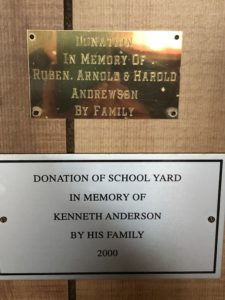 The school was used by the community for more than just school during the week. It was also used as a church and funerals were also held there as were town meetings. In 1890, Rev Baker from Haddam came down and held revival meeting for several days.
The school was used by the community for more than just school during the week. It was also used as a church and funerals were also held there as were town meetings. In 1890, Rev Baker from Haddam came down and held revival meeting for several days.
There was no well on the school grounds and water was carried from the the Campbell place a quarter mile west of the school. The teacher would send the boys out to get the water which was a welcomed chore among them as it gave them a ftime out of class.
The students brought their own lunches to school. It mostly consisted of cornbread and molasses. Some of the molasses was so thick that it would drip from the bread to the fingers as it was eaten. In the thirty’s when times were so hard it wasn’t uncommon for kids to bring lard sandwiches to school for lunch.
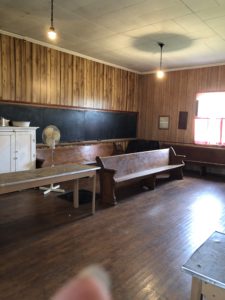 In 1888 there was a terrible snow storm with a combination of bitter cold weather. The pupils left the school house to go to the drug store east of the school. The storm was so terrible they held hands to get to the store. Will’s father came to get him and his brothers and sisters. They lived one mile north of the school. It was so bad he decided to leave the children at the store and headed back to the farm alone. Before he left he bought a whip to keep his horse going north against the strong wind. Several times his horse would turn around, but he pressed on and finally made it home. His fingers were frozen around the whip so he could not get them loose and when he got into the house he couldn’t talk due to the cold wind in his lungs. Wills’s mother was quite alarmed about the children because he could not talk and tell her where they were.
In 1888 there was a terrible snow storm with a combination of bitter cold weather. The pupils left the school house to go to the drug store east of the school. The storm was so terrible they held hands to get to the store. Will’s father came to get him and his brothers and sisters. They lived one mile north of the school. It was so bad he decided to leave the children at the store and headed back to the farm alone. Before he left he bought a whip to keep his horse going north against the strong wind. Several times his horse would turn around, but he pressed on and finally made it home. His fingers were frozen around the whip so he could not get them loose and when he got into the house he couldn’t talk due to the cold wind in his lungs. Wills’s mother was quite alarmed about the children because he could not talk and tell her where they were.
Many cattle and horses were lost during the storm. Most of the quail froze to death and for several years there were very few quail in the area.
In the early 1900’s a Salvation Army group camped on the school ground and set up a large tent and had a series of meetings. Many people from far and near came to the services. There was music, made with tambourines and a small portable organ. Some of the people brought their own instruments and played special numbers. The seats in the tent were made of board planks and were without backs.
Sunday School was conducted in the school house on Sunday afternoons. Some of the nearby ministers would speak. Rev. Walter Nelson and Rev. White and a friend held special meeting in the school for several weeks. A large number of people would attend.
The present school house was built in 1900 to replace the former one. It was a nice large building with a full basement. Later a storm cellar was constructed in the basement and a propane furnace was installed. A new well was dug and at the present time it has running water and inside rest rooms.
When the new school house was opened in 1911 the Board Members were A.J. Anderson, Otto Nelson and C.A. Olson. Ester Nelson, was the first teacher in the new building. She had 52 students in 1911 and 58 in 1912. Her salary was 60.00 a month.
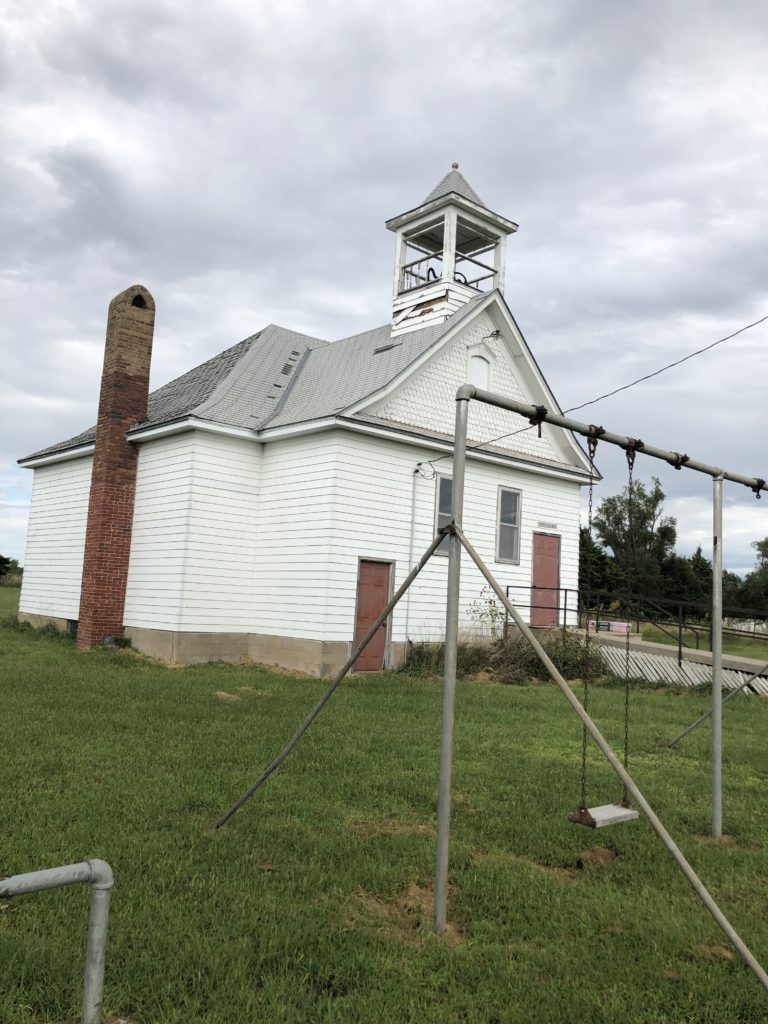
Listed are the teachers through the years as follows:
A.A. Harris 1889-1890, J.A. Baird 1891, Eire Anderson 1892, P.G. Sione 1893-1894, Fammy Hakes 1895, Emma Cunningham 1896, Luseua Beffe 1897, Effie Howard 1898, Mary Patterson 1899, H.L. Allen 1900, Stella Johnson 1901, Alice Howley 1902, Eva McCracken 1903, Ara Damon 1904-1905, Laren Misner 1906, Cora Simpson 1907, Josephine Olson 1908, Hilda Nelson 1909, Berth Campbell 1910, Ester Nelson 1911-1912, Ara McCracken 1913, Verlin Bonar 1914, Ada Haukenberry 1916-1917, Ester Nelson 1918, Netta Sterba 1919, Della McCracken, 1920-1922, John N. Holmberg 1923, Florence E. Henderson 1924-1925, Melvin M. Smart 1926-1928, Hazel Pickard 1929-1930, Raymond A. Olson 1931-1932, Merle Pickard 1933-1934, Laurene Anderson 1935-1936, El Vera Peterson 1927-1938, Irene Johnson 1939-1941, Mrs. Mabel Schulz 1943, Muriel Flear and Mable Schulz 1943, Opal Jurey 1944-1946, Mable Schulz 1947-1948, Anna Belle Back 1949, Flossie Olson 1950-1952, Mable Schulz 1953-1954, Dick Payeur 1955-1956, Vernus Lange 1957-1958, Mrs. V. Lange and Mrs. M Kunc 1959, Mary Kunc 1960.
No records were kept before 1889.
Beginning in 1945 the Grahm School closed and sent it’s students to Brantford. In 1951 part of the Weaver district consolidated with Brantford. In 1952 a school bus was purchased and in 1950 Marcotte district consolidated with Brantford. In 1961 the Brantford District was closed and consolidated with Cuba, Clifton, Clyde, Agenda and Haddam, with Clifton receiving the larger part of the district.
The Brantford Township bought the school house, and it is now used as a polling place and a community center. The Brantford Lucky 4-H and H.D.U. also use the building to hold meetings.
Nancy Wilkinson and Harvey Lundquist were the last two students to graduate from Brantford. The last board members were Roloand Lundquist, Nyle Sarff and James Kalivoda. The job of closing the school was not an easy one, but with fewer and fewer students every year there was no choice. The building now stands in good condition, as a landmark of the past.
Brantford’s Zion Lutheran Church
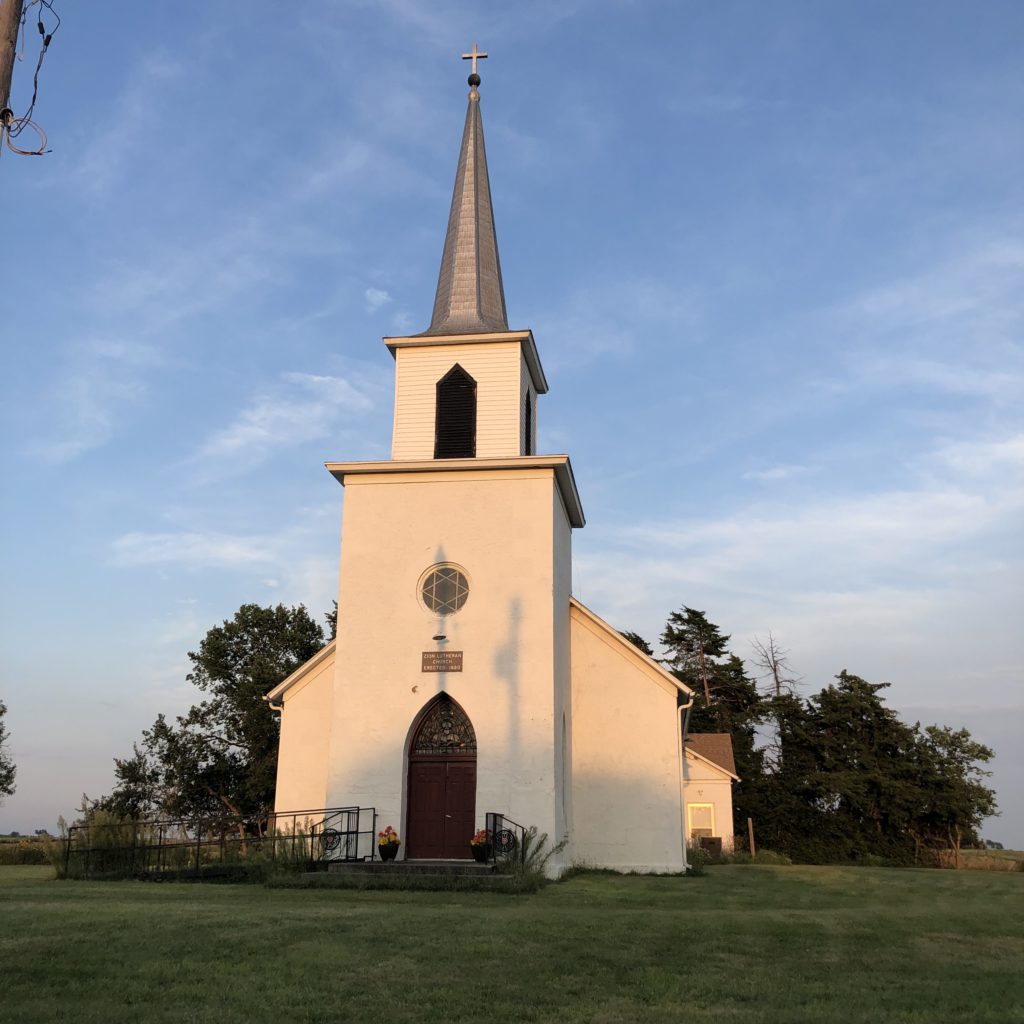
Brantford Township
Brantford, Washington, Kansas
A short distance south east of the old Brantford Store in Washington County, Brantford township, stand a beautiful stucco covered stone church, with a tall steeple pointing heavenward. In 2018 it was sold for a dollar to a private party.
The early settlers who helped to build this “Place of Worship” have long ago answered the final summons, but the surrounding farms are tilled by their children’s children, who are carrying on the work as they believe their ancestors would have wished them to do.
This community was settled by these immigrants who came from Sweden in 1868. Many others followed and joined this group in the next few years. They took homestead claims and established homes, dugouts, and sod houses, or small structures made from stone. Life was lonely and strenuous, for it took many hours to build necessary shelter and with only crude tools and little or no money.
Their spiritual needs, as well as their physical needs, must be planned, so a meeting was called on May 12, 1874, for the purpose of organizing a Swedish Lutheran Church. This first meeting was most likely held in one of the homes.
Rev. Chillen of the Swedesburg Lutheran Church was elected chairman of this meeting and was asked to preach one Sunday a month. Each family was to pay 5 dollars a year towards his salary. The following signed their names indicating their desire for an organized congregation: Johannes Peterson, Niles P. Carlson, Charles Linn, Carl Anderson, AE Dahl, Erick Erickson, John Westling, Andrew Nelson, Gust Nelson, Adolf Carlson, SN Almquist, PN Almquist, Charley Nelson, and AM Larson.
In February 8 1875, a committee was appointed to select a location for a church and cemetery. A two acre plot was donated for a cemetery within a short distance of the church site by Eric Erickson, grandfather of the late Walter A Erickson.
The church building was to be made of native stone, dimensions to be 30 ft by 45 ft, and AM Larson was to supervise the building. The work was free labor, done by the members of the congregation.
Quarrying and hauling rock from the limestone hills in the north was a tremendous job and the actual building did not get under way that year. The furnishing in the beginning were very primitive. A small table was used as an Altar and Pulpit with pews made of 12 inch boards laid on bricks.
Singing was done without accompaniment until 1895 when a reed organ was purchased. In 1892, chairs were purchased. A pulpit, altar table, and railing was built by Rev. J. Holcomb and ready for the Christmas Matins Service.
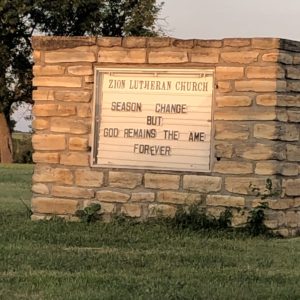 In 1893 a belfry and steeple were built. In 1898 the church was stuccoed, and in 1899 new pews were purchased. In 1906 the present bell was hung in the belfry. In 1909 the parsonage and other buildings were added and Rev. August A Norden and family moved in that following summer.
In 1893 a belfry and steeple were built. In 1898 the church was stuccoed, and in 1899 new pews were purchased. In 1906 the present bell was hung in the belfry. In 1909 the parsonage and other buildings were added and Rev. August A Norden and family moved in that following summer.
In 1911 a new altar was built and a furnace added. A piano was given by the Luther League, and in 1916 a new organ was purchased.
The 50th Anniversary was celebrated November 9, 1924. Rev. CO Nordell was pastor. A new furnace was installed and in 1946 the front of the church interior was also improved by adding three Gothic arches.
The Parish Hall was added in 1948. JA Peterson was the builder and Gus Noren was the general supervisor. In 1949 a new tile floor was laid and other improvements were made. Natural gas was piped to the church and Parish Hall. A “Multiples” which holds confirmation pictures was added at this time.
As memorials, the altar rail and kneeler were added by LG Noren in memory of his son, Walter, who lost his life in WWII. An altar by Luther Leaguers, cross and candle sticks were given by S. Anderson and family in memory of Mrs. Anderson. An individual communion set for Holy Communion was given by P. August Peterson and family in memory of Mr. Peterson.
The electric organ was installed in 1958 and purchased through “In Memorium Gifts” for Albert Carlson and Anna West.
Other memorials: Offering plates and Altar vases given in memory of Selma Peterson by her family; a “guest register stand” in memory of the AV Erickson family and guest book in memory of Walter A. Erickson: a Baptismal fount given by Mr. Fred Peterson, Miss Beda Peterson and Mr and Mrs. Norman Birkman, and a Bulletin Board by Mr. and Mrs. Fred Peterson.
The 90th Anniversary of the Zion Lutheran Church was celebrated September 13, 1964 with the Rev. Carl Schneider as guest speaker.
I will conclude this post for now as it seems to have gotten a bit long. I hope you enjoyed going back into history with me and if you have anything that you might add to what I have shared thus far please let me know so I can add it. It’s my hope to give a little more insight to some of our other lost communities in Washington county in post to come as this was the HOME of our Nutsch/McCollum families.
No copyright infringement intended. Most of my sources here came from the little pamplet I found at a garage sale years ago LEST WE FORGET Memories of Brantford Township 1868 to 1966.
Lets keep our memories alive!
Happy Hunting
The Pierce Family Historian
